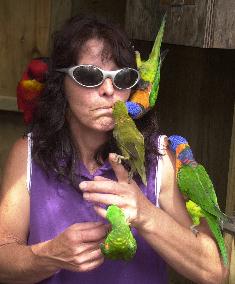A Communal Aviary
When
I first started keeping Lorikeets the advice from everyone was to keep only one
pair in each aviary. The reasons for this seemed obvious as birds were often
territorial and fights, sometimes to the death, would likely occur. So it was
one pair per aviary with babies being removed as soon as practical.
When
in May 2000 I obtained a breeding pair of Musks complete with their last five
offspring we had to place the five in a separate aviary. This experience was a
real eye opener for me as these busy little characters continually squabbled
and played and the noise from this gang was amazing.
Introducing other birds to
the gang was interesting as a larger bird, such as a Yellow-bib that could
seriously damage a musk, would have the complete gang to deal with if it tried
to pick on one individual musk.
I realized that the 'communal' aviary concept
was a much more natural way to keep these birds providing there was sufficient
room and enough hideaway time-out places where individual birds could hide.
Over the next year our two breeding pairs of Musks produced at least a dozen
babies and along with similar sized Scaly Lorikeets we kept them together in
several groups. The secret of successful sharing seemed to be having babies that
spent some time together when they were in their first three months. They
seemed to readily accept each other and friendships were formed from that early
age. Only when birds started to pair off as potential breeding pairs we found
it necessary to remove them to separate aviaries. When this happens then the
more serious squabbles will start although just about every bird will become
involved until peace breaks out again. Eventually space became a problem and
several larger 6metre long aviaries were built. Two of these became communal
aviaries when one having no less than thirteen birds, musks, scaly and a pair
of red-collars that were all born within a few weeks of each other. They had
all been sharing brooders and cages while they were hand raised from about 3 to
4 weeks old.
Entering this aviary is an exciting experience for most people.
All of the birds fly over to land on head/shoulders and want to play. They will
search all over a human in case food is being hidden, remove sunglasses, preen
hair, inspect ears and jewelry, then several will always want to roll over to
have their tummies tickled. I have never met a human yet who has not visited
this communal aviary and left without a big smile of pleasure and amazed at the
friendliness of the birds.
If
you are planning a communal aviary then these are my recommendations.
- Make the
aviary quite large, I prefer about 6 metres long there should be several nest
boxes in the aviary.
- Have plenty of hide-away spaces, I use 300mm to 1M lengths
of plastic drainage tube 100mm diameter, plastic coke bottles with the narrow
end cut off to make a 40mm opening, these are all held up with long plastic
cable ties, and various bits of plywood on the aviary frame behind which birds
can hide. I also have a couple of old tee-shirts/towels hanging from the aviary
roof, these are great for birds to get inside.
- Many perches at all levels. Long
and short types. Fruit tree branches are a favorite.
- Plenty of food dishes, at
least one per three birds so that there is no fighting in trying to get at the
food. Have sets of dishes for wet and dry mixes.
Itís much better to have four
or five small dishes rather than one or two larger dishes.
- Lots of toys -
swings, lengths of knotted rope, plastic chains etc.
- Every few weeks a tree
branch with lots of leaves should be placed in the aviary, from fruit trees is
a favorite although tee tree and bamboo are quite good - and the bamboo makes
slippery perches which can be great fun for the birds.
Keep
a lookout or ear out for any very noisy squabbles or excitement breaking out.
It may be just a cat or worse a serious fight developing. If one bird is trying
to dominate the aviary then it may be worth removing it for a while until it
quietens down. Timeouts like these seem to have the desired effect and when
reintroduced the offending bird will usually be better behaved, as it really
dislikes being removed from its friends. Also lookout for any bird that is
alone most of the time or is generally chased away by all of the others. It
could be weaker or physically smaller and may not be suitable for a communal
aviary.
If
a new bird or two is introduced to the communal aviary then observe them for a
while. Generally most will become accepted quite quickly if they are a juvenile.
Introducing a mature bird or a breeding pair is NOT a good idea, as they will
soon try to dominate the aviary.
With a little bit of advance planning the move to a communal aviary
should not be too difficult. If the birds are all juveniles and about the same
physical size then most personality issues amongst the birds will be
avoided.
A communal aviary is now a MUST for me. Its such an exciting place, there
is always activity and never a bored bird or human visitor.
Some of the birds sharing the same aviary. |
